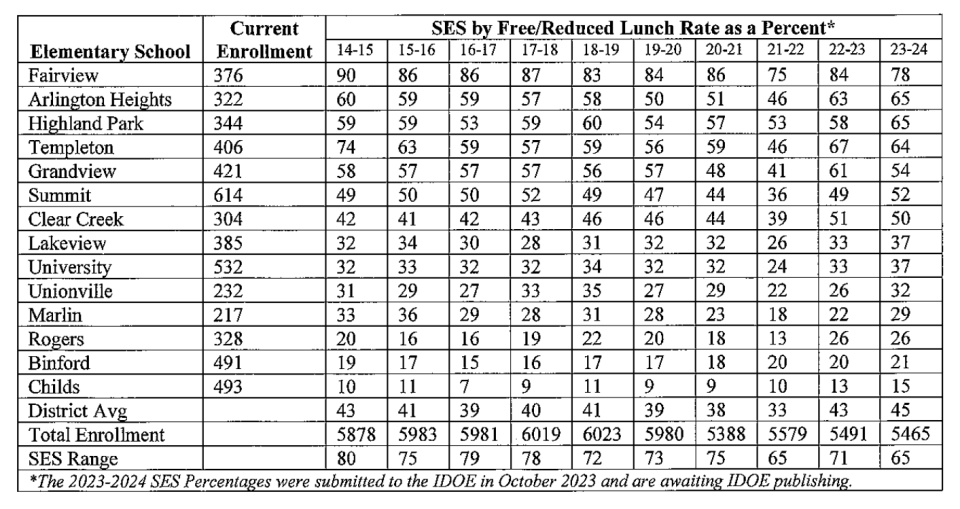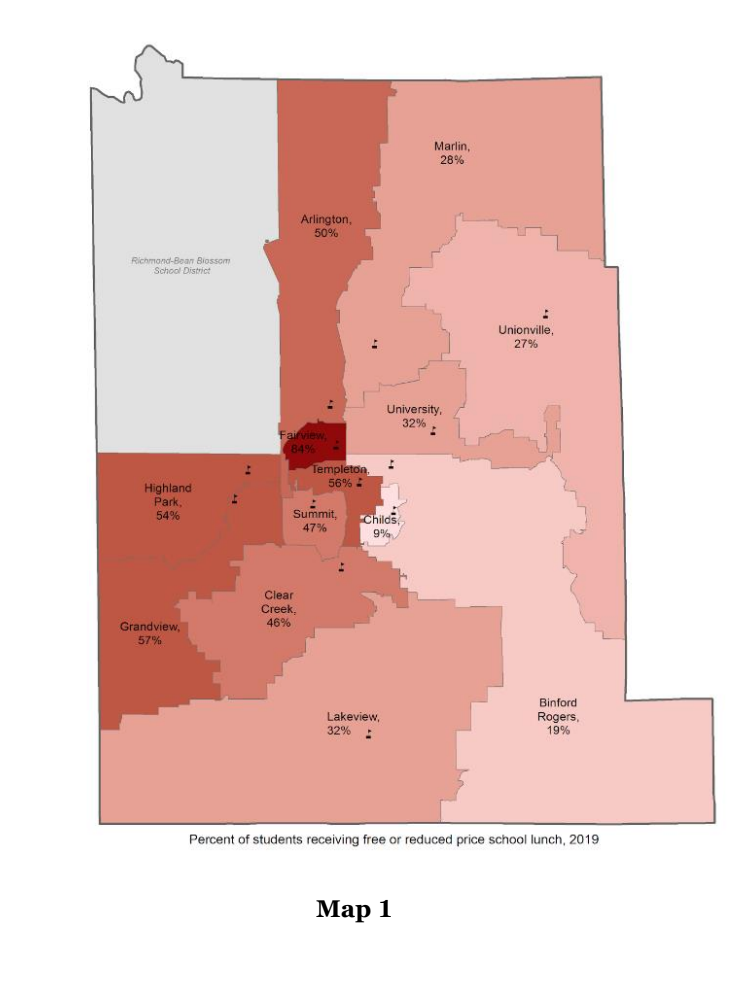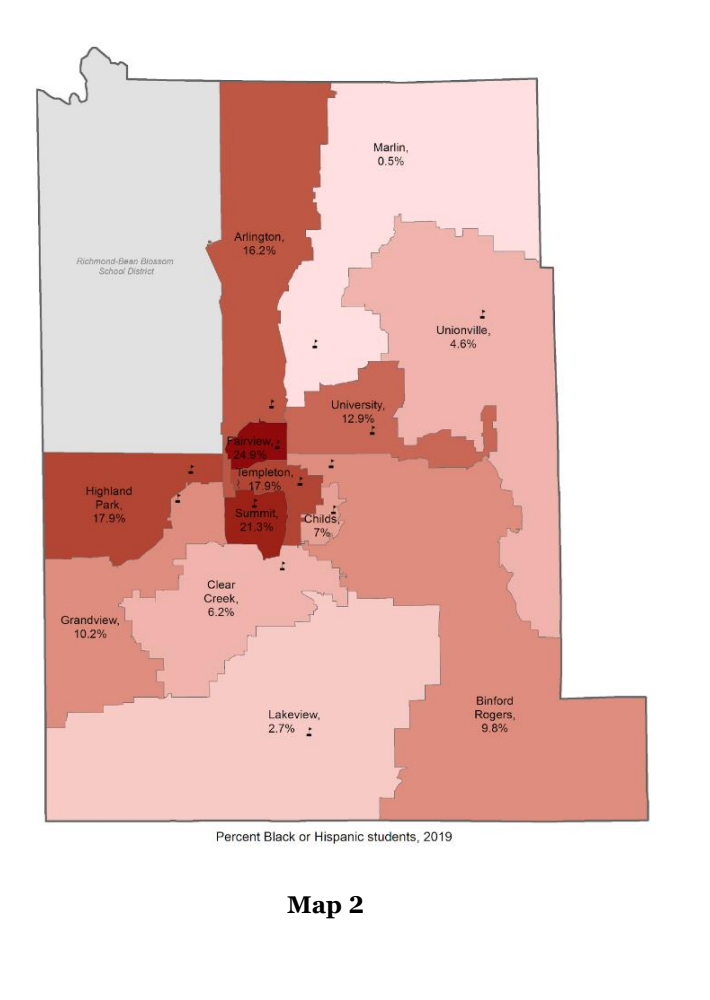MCCSC elementary consolidation proposal rooted in 1997 redistricting
In 1997, Monroe County Community School Corp. redistricted its school boundaries, incorporating changes to balance the growing high school populations at Bloomington South and North, as well as strengthen the character of Bloomington’s “neighborhood schools” that were more attuned to the needs and demographics of their specific neighborhoods.
At Fairview Elementary, that meant incorporating more conventionally working-class neighborhoods and public housing projects into the school boundary, providing increased accessibility to families on Bloomington's southwest side to walk to the school.
The redistricting also changed the headcount of Fairview students on the state's free and reduced price lunch program, a measure often used to gauge socioeconomic status (SES) at public schools based on the program’s income eligibility guidelines. Nearly four in five students at Fairview were eligible, a statistic that’s remained relatively stable in the decades since.
In the 2023-24 school year, 78% of Fairview's students were enrolled in free and reduced lunch, the highest of any elementary school in the district.
The MCCSC school board asked Superintendent Jeff Hauswald to come up with a proposal to balance SES in the district. At last month's school board meeting, Hauswald introduced a proposal to merge Childs and Templeton and/or University and Fairview elementary schools across grade levels, with the goal of reducing SES disparities.
The proposal, which also drew on free and reduced lunch enrollment data from the IDOE, showed how different enrollment rates are between some of Bloomington's neighboring schools.

Fairview and University elementary, which share a north-south border along College Ave., show a more than 40% gap in free and reduced lunch enrollment, with University at 37% and Fairview at 78%.
Templeton and Childs showed a more significant gap, at 49%, despite their small and interlocking zoning boundaries.
But beyond socioeconomic status, data from the IDOE shows similar gaps in MCCSC schools across racial demographics.
Of MCCSC’s Black elementary school students, 63% attend the five elementary schools with the highest free and reduced lunch enrollment, compared to 33% of the white student population. Fairview, the school with the highest free and reduced lunch enrollment, also has the largest share of Black students, nearly 20% of the total Black elementary school population, according to IDOE statistics.
For many advocates of equity reform in Monroe County, discussions of improving socioeconomic and educational equity across elementary schools are inextricable from the broader topics of class and racial segregation patterns that accompany them, and the history of attempts within the district to remedy them.
The impact of redistricting in MCCSC
While the 1997 redistricting helped to maintain the "neighborhood school" feeling of Fairview on Bloomington's southwest side, Steve Hinnefeld, author of the K-12 Indiana education blog School Matters and former Herald-Times education reporter, said for many, the 1997 redistricting also cemented an existing perception of Fairview as a less desirable school.
“Westside schools in general have a bad reputation,” Hinnefeld said. “There used to be this supposed shorthand among Realtors, that you would tell people, ‘You don’t want to send your kids to the ‘view’ schools,’ being Fairview, Grandview and Broadview, which is now Summit.”
That perception remains today. The website Niche, which produces scores for neighborhoods, colleges, and K-12 schools based on user reviews and data from the national and state DOE, gives Fairview a "B" score, ranking it as the No. 452 best public elementary school in Indiana. Childs, by contrast, received an "A," and is ranked No. 32 in the state, 420 spots ahead of Fairview. The two schools are within a few miles of one another.
An Indiana University capstone report on achieving equity in schools
How to balance the disparities in race and class at MCCSC elementary schools has been a recurring topic in the corporation in the decades since the 1997 redistricting. At the same time, concerns about the disruption further redistricting could cause have increased.
In summer 2020, the Indiana Center for Public Education (ICPE) of Monroe County, a group that advocates for stronger public schools in Indiana, collaborated with a capstone class at Indiana University’s O’Neill School of Public and Environmental Affairs to examine the “impact on segregation of students by race and income” of MCCSC’s current school attendance zone boundaries, or “catchment zones,” and propose potential solutions.


Led by IU associate professor Ashlyn Nelson, the report found “sharp disparities across catchment zones along racial and socioeconomic lines,” citing in detail the frequent correlation between boundary zones with the most non-white students and those with the highest number of students on free and reduced lunch. The report proposed the use of drawing intentionally “irregular” zones as one potential means of reducing these disparities.
Nelson said the study had limitations. Student researchers worked with broader, publicly-accessible data from the IDOE and a limited 10-week timeframe for the summer course. However, she said, the class’ work showed attempts to balance disparities through rezoning could be achieved.
“We have statements from the IDOE transportation director saying, ‘I can literally reroute the transportation lines within 30 minutes to achieve what you wanted to do,’” Nelson said. “There is no actual, real technical barrier to doing this.”
Yet when ICPE-Monroe finally shared the capstone report in the spring of 2021 – almost a year after it was initially completed – it published, alongside the report, concerns about how rezoning could negatively impact schools in the short term by leading unhappy families to “flee the public school system” through school choice vouchers.
“The choice environment casts families as consumers. They can turn away from the public school system to charter or voucher schools, or leave their own school district for another, and state tuition funds will follow them,” the statement attached the report says. “The job of school boards is therefore more complicated than before.”
Keri Miksza, chair of ICPE-Monroe, said she doesn’t believe concerns about schools being negatively impacted by school choice vouchers apply to Hauswald’s proposal for elementary school consolidation. Miksza said MCCSC already has students change schools between grades in the case of Rogers and Binford Elementary, which are split into primary and intermediate elementary schools.
“Redistricting is a big shakeup for 14 elementary schools, whereas this is a little bit less of a shakeup,” Miksza said. “I don’t think people will lean on choice if those options of choice are due to consolidating.”
Miksza added while the proposal is still in its early stages, she’s in favor of attempts to remedy the disparities between schools, and trusts the elected board.
Discussions begin with the MCCSC school board
April Hennessy, president of the MCCSC school board, emphasized Hauswald’s proposal is far from a vote, and said the board is still hearing other proposals for how to balance socio-economic status across schools.
“I will say we have actually received emails both very much in support of this possibility, we have received emails from people in support of balancing SES but perhaps exploring other possibilities like a full redistricting, and we’ve heard from people who were adamantly against basically everything,” Hennessy said. “Unlike some issues, the opinion seems to be fairly dispersed across the spectrum.”
Hennessy said while the board begins discussions of Hauswald’s proposal and other ways to balance disparities, she encourages concerned parents and families to look at the “big picture.”
“I know it’s hard when you’re thinking about the impact to your own family or children, but I really firmly believe in collective care,” Hennessy said. “I would like for us to think about how we can collectively care for the children of this district, and in order to do that, we will have to make some adjustments that will impact the whole district in some way.”
The first regular board meeting of the year will be Jan. 23, when the board will discuss Hauswald’s proposal and allow for public comment.
Reach Brian Rosenzweig at brian@heraldt.com.
This article originally appeared on The Herald-Times: Bloomington's MCCSC looks for socioeconomic balance

